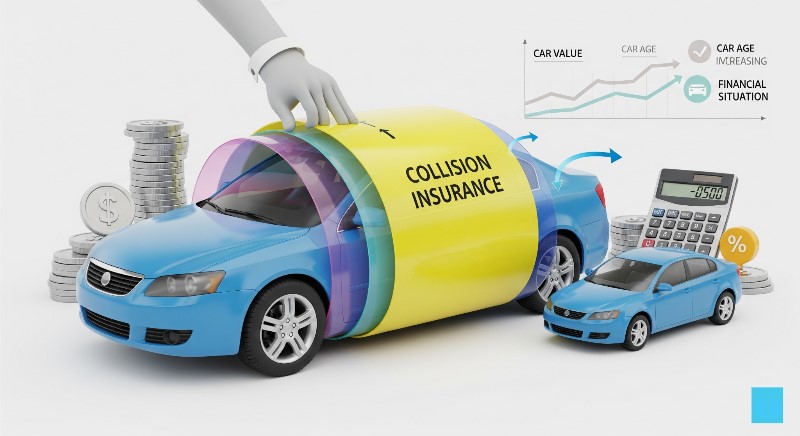Knowing when to drop collision insurance may be a hard monetary choice. At the same time as it gives precious protection, specifically for more modern motors, but it isn’t always vital as your automobile ages or depreciates in cost. Information, the right time to put off this insurance could prevent masses of greenbacks a year without significantly increasing your risk.
In this article, we’ll explore what collision insurance covers, the elements that affect your selection, actual-existence examples, and frequentlyy asked questions that will help y, ou with a bit of luck, decide when to drop collision insurance from your auto policy.
What Is Collision Insurance?
Before you make a decision on when to drop collision insurance, it is critical to understand what it truly covers. Collision coverage pays for damage to your automobile because of an accident, regardless of who’s at fault. This consists of:
- Crashing into another vehicle
- Hitting an object (like a pole or guardrail)
- unmarried-car accidents (e.g., rolling over)
For example, if you hit a tree while swerving to keep away from a deer, collision coverage might cover your vehicle’s restoration fees (minus your deductible).
If you’re thinking about when to drop collision insurance, knowing the precise situations it applies to allows weigh its significance against your vehicle’s fee and your monetary situation.
Why People Carry Collision Insurance
Many drivers carry collision insurance to guard against the high cost of repairs or general loss. Particularly while the car is more modern,the fee of restoration or replacement could be significant. Consequently, evaluating when to drop collision insurance is commonly extra relevant for older drivers or people with lower insurance costs.
For example, if you personal a vehicle that’s worth $25,000, collision insurance makes sense. However, if the automobile is now worth $3,000, it might be time to reconsider. Comparing when to drop collision insurance frequently comes right down to whether the premiums you pay are justified by using the capacity payout.
How Collision Insurance Works with Deductibles
Know-how: your deductible is key to knowing when to drop collision insurance. A deductible is the amount you pay out of pocket earlier than your insurance kicks in.. Commodities vary from frfrom500 to $1,000.
For instance, if your vehicle sustains $1,2 in damages and you’ve a $1,000 deductible, your insurer simply pays $ hundred. If your rates for collision insurance are $three hundred annually, you are probably paying morethan you’ll ever claim. In such cases, getting to know when to drop collision insurance becomes a practical monetary approach.
Key Factors
There’s no widespreadrule, but numerous important elements can assist in making a decision when to drop collision insurance:
1. Vehicle Value
The decrease the modern-day marketplace fee of your automobile, the less experience it has to hold collision coverage. A fashionable rule of thumb is: in case your automobile is worth much less than 10 times your annual collision top rate, it might be time to drop it.
As an example, in case you’re paying $400 a year for collision coverage and your vehicle is worth simplest $three,000, it is time to keep in mind when to drop collision insurance.
2. Your Financial Situation
If you can find the money to repair or update your automobile out of pocket, you would no longer need the insurance. Human beings with emergency financial savings or access to low-interest credit are probably more relaxed compared to those who rely on collision insurance based on their monetary cushion.
3. Your Driving Habits and Risk
If you drive often in excessive-traffic regions, shuttle lengthy distances, or stay in areas with icy roads, your threat of an twist of fate is higher. In that case, identifying when to drop collision insurance will become a more nuanced decision that must weigh risk against the fee.
4. Loan or Lease Obligations
If your vehicle is financed or leased, your lender, in all likelihood, requires you to keep complete insurance. In such situations, asking when to drop collision insurance is moot till the loan is paid off.
Real-Life Examples
Example 1: High-Value Vehicle
Jack owns a 2021 SUV valued at $28,000. He pays $350 per year for collision coverage with a $500 deductible. Because the potential loss is significant, Jack decides now is not the time to drop collision insurance.
Example 2: Older Car with Low Value
Maria drives a 2008 sedan really worth approximately $2,000. Her annual collision top class is $400, and her deductible is $1,000. Even supposing her car is totaled, the most she’d get from the insurer is $1,000 after the deductible. For her, the question of when to drop collision insurance is effortlessly answered.
Example 3: Paid-Off Mid-Value Car
Ethan’s 2014 car is worth $5,500, and he will pay $300 consistent with year for collision insurance. He’s a safe driver without a history of injuries. Whilst he ought to drop it, he decides to hold it for one greater year and reassess later. His desire displays how personalized the decision to drop collision insurance can be.
Pros and Cons of Dropping Collision Insurance
allow us to break down the benefits and disadvantages to better understand when to drop collision insurance:
Pros:
- Lower rates: losing this coverage can prevent $2–$500 in line with yr.
- Higher fee-to-benefit Ratio: in case your car’s price is low, the go back to the top class isn’t worth it.
- Simplified coverage: Fewer coverages make it simpler to recognize your policy.
Cons:
- Out-of-Pocket expenses: You must pay for all repairs or substitute yourself after an twist of fate.
- Confined protection: No monetary cushion if you’re at fault in a collision.
- Risk control: If you’re in an excessive-threat region, the decision on when to drop collision insurance may cost you later.
How to Calculate If It’s Time
Use this formula to determine when to drop collision insurance:
(automobile’s market cost – Deductible) – Annual Collision top class = net advantage
If the internet advantage is low (say, much less than $500), it’s time to take into account dropping it. This facilitates choosing when to drop collision insurance based on actual numbers rather than guesswork.
Alternatives After Dropping Collision Insurance
After determining when to drop collision insurance, ensure your remaining coverage is adequate. Recollect:
- Legal responsibility insurancinsuranceired with the aid of regulation and covers damages you cause to others.
- Comprehensive coverage: Covers non-collision incidents like robbery, vandalism, or climate-related harm. You would possibly want to hold this, even in case you drop collision.
Understanding what’s left after deciding when to drop collision insurance helps keep away from being underinsured.
FAQs: When to Drop Collision Insurance
Q1: At what car age do I need to drop collision insurance?
There may be no constant age, but many remember ‘’while to drop collision coverage’’ as soon as the auto is over 8–10 years old and its marketplace value is low..
Q2: Is it safe to power without collision coverage?
Yes, as long as you’re prepared to cover the cost of upkeep or a replacement. Figuring out when to drop collision insurance needsto contain aneconomic hazard assessment.
Q3: Does dropping collision coverage affect liability insurance?
No, legal responsibility and collision are separate. Understanding ‘’while to drop collision insurance’’ gained’t impact your state-required legal responsibility limits.
Q4: Can I add collision insurance returned later?
Sure, however, you could need an inspection or approval from your insurer. Usually, verify this before identifying when to drop collision insurance.
Q5: Do I have to drop each collision and comprehensive at the same time?
Not necessarily. Despite the fact that you make a decision when to drop collision insurance, comprehensive may also nevertheless be well worth maintaining, especially if your region is susceptible to robbery, storms, or wildlife-associated incidents.
Conclusion
Deciding on when to drop collision insurance is a smart financial move when done properly. If your automobile is antique, its fee is low, and you could manage to pay for repairs, losing this insurance may make it ideal. However, for more modern vehicles or riskier drivers, it can nonetheless offer essential safety.
Evaluate your automobile’s fee, your top-class charges, your deductible, and your financial situation to make an informed decision. Ultimately, the query of when to drop collision insurance depends on balancing risk with monetary savings, and now, you’re ready to make that decision confidently.
Read More: Do You Need Full Coverage on a Financed Car?



